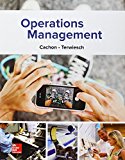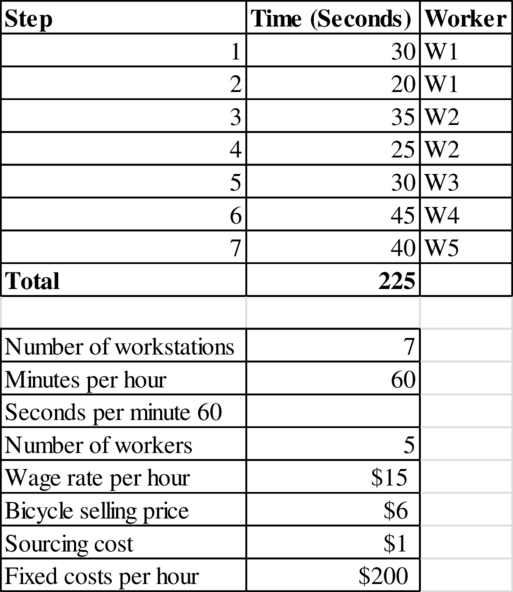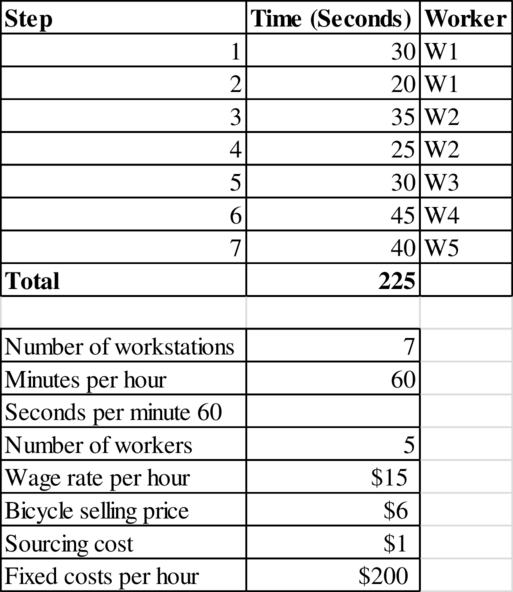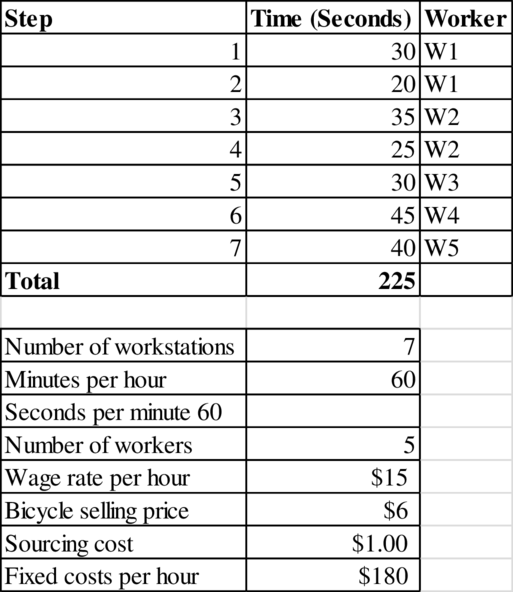
Concept explainers
a)
To determine: The cost of direct labor for the bicycle.
a)
Explanation of Solution
Given information:

Identification of bottleneck:
Worker 1 performs Step 1 and Step 2 with a total time of 50 seconds.
Worker 2 performs Step 3 and Step 4 with a total time of 60 seconds.
Worker 3 performs Step 5 with a time of 50 seconds.
Worker 4 performs Step 6 with a time of 45 seconds.
Worker 5 performs Step 7 with a time of 40 seconds.
Therefore, the bottleneck is Worker 2 with 60 seconds.
Calculation of cost of direct labor for the bicycle:
The cost of direct labor per bicycle is $1.25.
b)
To determine: The profit per hour of the company.
b)
Explanation of Solution
Given information:

Calculation of profit per hour:
The bottleneck time is 60 seconds. Therefore, 60 units are produced every hour. Therefore, the flow rate is 60 units per hour.
The profit per hour is $25.
c)
To determine: The profit per hour of the company if the sourcing cost is 10% cheaper.
c)
Explanation of Solution
Given information:

Calculation of profit per hour:
The bottleneck time is 60 seconds. Therefore, 60 units are produced every hour. Therefore, the flow rate is 60 units per hour.
The profit per hour is $31.
d)
To determine: The profit per hour of the company if the fixed cost is 10% less.
d)
Explanation of Solution
Given information:

Calculation of profit per hour:
The bottleneck time is 60 seconds. Therefore, 60 units are produced every hour. Therefore, the flow rate is 60 units per hour.
The profit per hour is $45.
e)
To determine: The profit per hour of the company if the bottleneck time is reduced by 5 seconds per unit.
e)
Explanation of Solution
Given information:

Calculation of profit per hour:
The bottleneck time is 55 seconds. Therefore, the flow rate is:
The profit per hour is $52.25.
Want to see more full solutions like this?
Chapter 4 Solutions
Operations Management With Connect
- Atlas Inc. is a toy bicycle manufacturing company producing a five-inch small versionof the bike that Lance Armstrong rode to win his first Tour de France. The assemblyline at Atlas Inc. consists of seven work stations, each performing a single step. Stationsand processing times are summarized here:• Step 1 (30 sec.): The plastic tube for the frame is cut to size.• Step 2 (20 sec.): The tube is put together.• Step 3 (35 sec.): The frame is glued together.• Step 4 (25 sec.): The frame is cleaned.• Step 5 (30 sec.): Paint is sprayed onto the frame.• Step 6 (45 sec.): Wheels are assembled.• Step 7 (40 sec.): All other parts are assembled to the frame.Under the current process layout, workers are allocated to the stations as shown here:• Worker 1: Steps 1 and 2• Worker 2: Steps 3 and 4• Worker 3: Step 5• Worker 4: Step 6• Worker 5: Step 7Assume the workers are paid $15 per hour. Each bicycle is sold for $6 and includesparts that are sourced for $1. The company has fixed costs of $200 per…arrow_forwardene is working with the operations manager to determine what the standard labor cost is for a spice chest. He has watched the process from start to finish and taken detailed notes on what each employee does. The first employee selects and mills the wood, so it is smooth on all four sides. This takes the employee 1 hour(s) for each chest. The next employee takes the wood and cuts it to the proper size. This takes 43 minutes. The next employee assembles and sands the chest. Assembly takes 3 hour(s). The chest then goes to the finishing department. It takes 3 hour(s) to finish the chest. All employees are cross-trained so they are all paid the same amount per hour, $17.62. What is the standard cost per chest for labor? Round to the nearest penny, two decimal places.arrow_forwardA process of making chair is described as follows: Stage 1 Seat and back attached Stage 2 Legs attached The production speeds are 15 chairs per hour for Stage 1 and 30 chairs per hour for stage 2. The cycle time of the process is ______minutes. The flow time of the process is ______ minutes.arrow_forward
- Atlas Inc. is a toy bicycle manufacturing company producing a five-inch smallversion of the bike that Lance Armstrong rode to win his first Tour de France. The assembly lineat Atlas Inc. consists of seven work stations, each performing a single step. Stations andprocessing times are summarized here: Step 1 (30 sec.): The plastic tube for the frame is cut to size. Step 2 (20 sec.): The tube is put together. Step 3 (35 sec.): The frame is glued together Step 4 (25 sec.): The frame is cleaned. Step 5 (30 sec.): Paint is sprayed onto the frame. Step 6 (45 sec.): Wheels are assembled. Step 7 (40 sec.): All other parts are assembled to the frame.Under the current process layout, workers are allocated to the stations as shown here: Worker 1: Steps 1, 2 Worker 2: Steps 3, 4 Worker 3: Step 5 Worker 4: Step 6 Worker 5: Step 7a. What is the bottleneck in this process?b. What is the capacity of this assembly line, in finished units/hour?c. What is the utilization of Worker 4, ignoring…arrow_forwardSmooth Chin Device Company The Smooth Chin Device Company is a manufacturer of high-end electric razors. These razors are produced using a machine-paced process. For each razor, a tray with components enters the process at the beginning of a conveyor belt. The tray then passes through the six steps (consisting of various tasks) explained in the table below. Workers perform the assembly operations on the moving tray. The last step consists of an inspection of the then fully assembled razor. The activity times of the process are as follows: There are six workers, one at each of the six stations (A-F). They begin their workday at 8:00 a.m. and work steadily until 4:00 pm. (They are replaced with other workers for breaks and lunches, but the production is not slowed or stopped during these times.) Their hourly wage rate is $25 per hour. You can assume unlimited demand. What is the process capacity (you can ignore any start-up or empty system effects), in razors/hour?arrow_forwardConsider the example of the three-step process. The first step takes 20 minutes/unit, the second step takes 10 minutes/unit, and the third step takes 15 minutes/unit. Eachstep is staffed by one worker. What is the labor content of the process?arrow_forward
- Ted Short, manager of procurement at the Lake Luna Medical Center (LLMC), is starting a process to examine at the general process that is followed at his center for procurement of medical supplies at his facility. His first step is to develop a flowchart for the current process that employees at his center follow. He has asked you to draw that flowchart for him and make any obvious changes to shorten the process. Here are the key steps that are followed: The LLMC employee fills out a paper requisition and sends that to his department head for approval. The department secretary first examines the requisition to see if all needed information is present. If it is, then she sends to the department head for approval. If not, she returns to the employee for any needed corrections. The employee then returns the requisition to the department secretary for review again. Requisitions with the correct information are sent to the department head. The department head reviews the item to determine…arrow_forwardMr. Aris Benn manages an assembly line that produces a piece of equipment that is used to clean floors. The process to produce this piece of equipment consists of 10 steps. 1. set up a numerical example of the line balancing problem at hand.arrow_forward3-Step Process with Rework Consider the following three-step assembly operation with quality problems. All resources are staffed by one employee. The first resource has a processing time of 7 minutes per unit. The second resource has a processing time of 6 minutes per unit. The third resource has a processing time of 5 minutes per unit. With a 40% probability, the flow unit coming out of the third resource has to be reworked. In that case, the operations at the second and third resources are repeated. You can assume that (a) rework always succeeds (i.e. a unit going through the rework loop will always work after the third resource),and (b) the processing times for units in rework are the same as for regular units. A) For every unit of demand, how many units have to flow through the second step in the process? B) Where in the process is the bottleneck? Step 1, 2 or 3?arrow_forward
- Natura has to fill 7 orders for its clients. He requires placing the required product in work boxes and subsequently closing them properly so that the product reaches the customer correctly. The process consists of filling the box and later closing it. As the content of each box and the size of these is different, the filling and closing times of each order is different. These times are shown in the table below. Orders Place in box (minutes) Closing Box (minutes) 1 9 6 2 8 5 3 7 7 4 6 3 5 1 2 6 2 6 7 4 7 a) Find the sequence to complete the orders in the shortest time possible. b) Using a Gantt chart, find the total time in which all orders will be completed using the sequence from part a.arrow_forwardI Love Lucy: A Colorized Celebration - "Job Switching" clip https://youtu.be/K3axU2b0dDk Watch this short "I Love Lucy" clip. In it, you will see Lucy and her friend Ethel wrapping candies on an automatic assembly line. Their job is to make sure that each candy is wrapped. You will laugh when you see what happens as the speed increases on the line. Think about this clip from the point of view of operations management. This clip is much more than poor management techniques. So - what went wrong? What would you do to improve the process? Answer these questions with concepts from this week's readings.arrow_forwardRecently, some operations management experts have begun insisting that simply maximizing process velocity, which actually means minimizing the time it takes to process something through the system, is the single most important measure for improving a process. Can you think of a situation in which this might not be true?arrow_forward
 Practical Management ScienceOperations ManagementISBN:9781337406659Author:WINSTON, Wayne L.Publisher:Cengage,
Practical Management ScienceOperations ManagementISBN:9781337406659Author:WINSTON, Wayne L.Publisher:Cengage, Operations ManagementOperations ManagementISBN:9781259667473Author:William J StevensonPublisher:McGraw-Hill Education
Operations ManagementOperations ManagementISBN:9781259667473Author:William J StevensonPublisher:McGraw-Hill Education Operations and Supply Chain Management (Mcgraw-hi...Operations ManagementISBN:9781259666100Author:F. Robert Jacobs, Richard B ChasePublisher:McGraw-Hill Education
Operations and Supply Chain Management (Mcgraw-hi...Operations ManagementISBN:9781259666100Author:F. Robert Jacobs, Richard B ChasePublisher:McGraw-Hill Education
 Purchasing and Supply Chain ManagementOperations ManagementISBN:9781285869681Author:Robert M. Monczka, Robert B. Handfield, Larry C. Giunipero, James L. PattersonPublisher:Cengage Learning
Purchasing and Supply Chain ManagementOperations ManagementISBN:9781285869681Author:Robert M. Monczka, Robert B. Handfield, Larry C. Giunipero, James L. PattersonPublisher:Cengage Learning Production and Operations Analysis, Seventh Editi...Operations ManagementISBN:9781478623069Author:Steven Nahmias, Tava Lennon OlsenPublisher:Waveland Press, Inc.
Production and Operations Analysis, Seventh Editi...Operations ManagementISBN:9781478623069Author:Steven Nahmias, Tava Lennon OlsenPublisher:Waveland Press, Inc.





